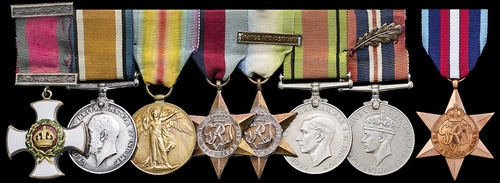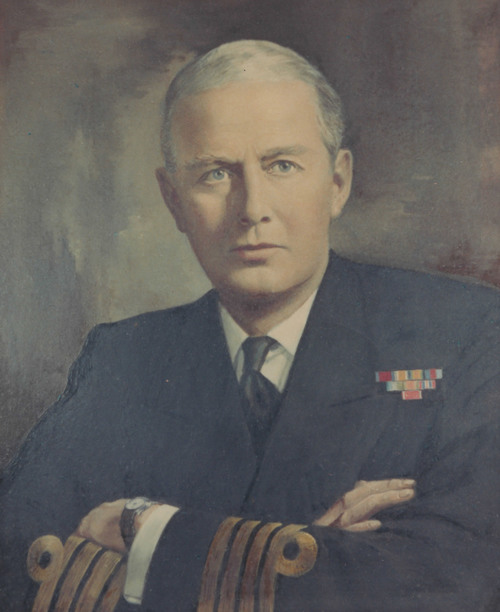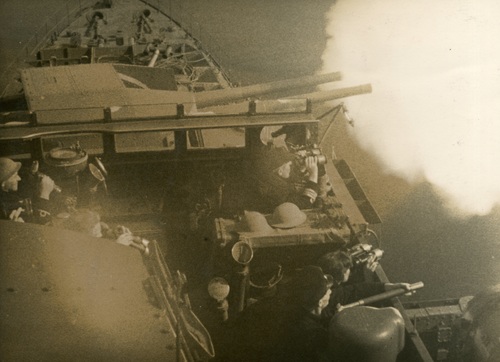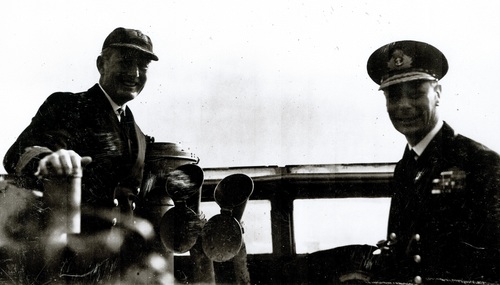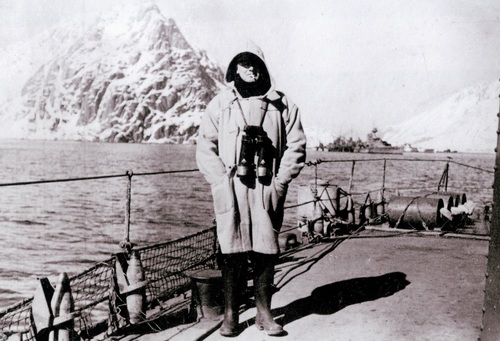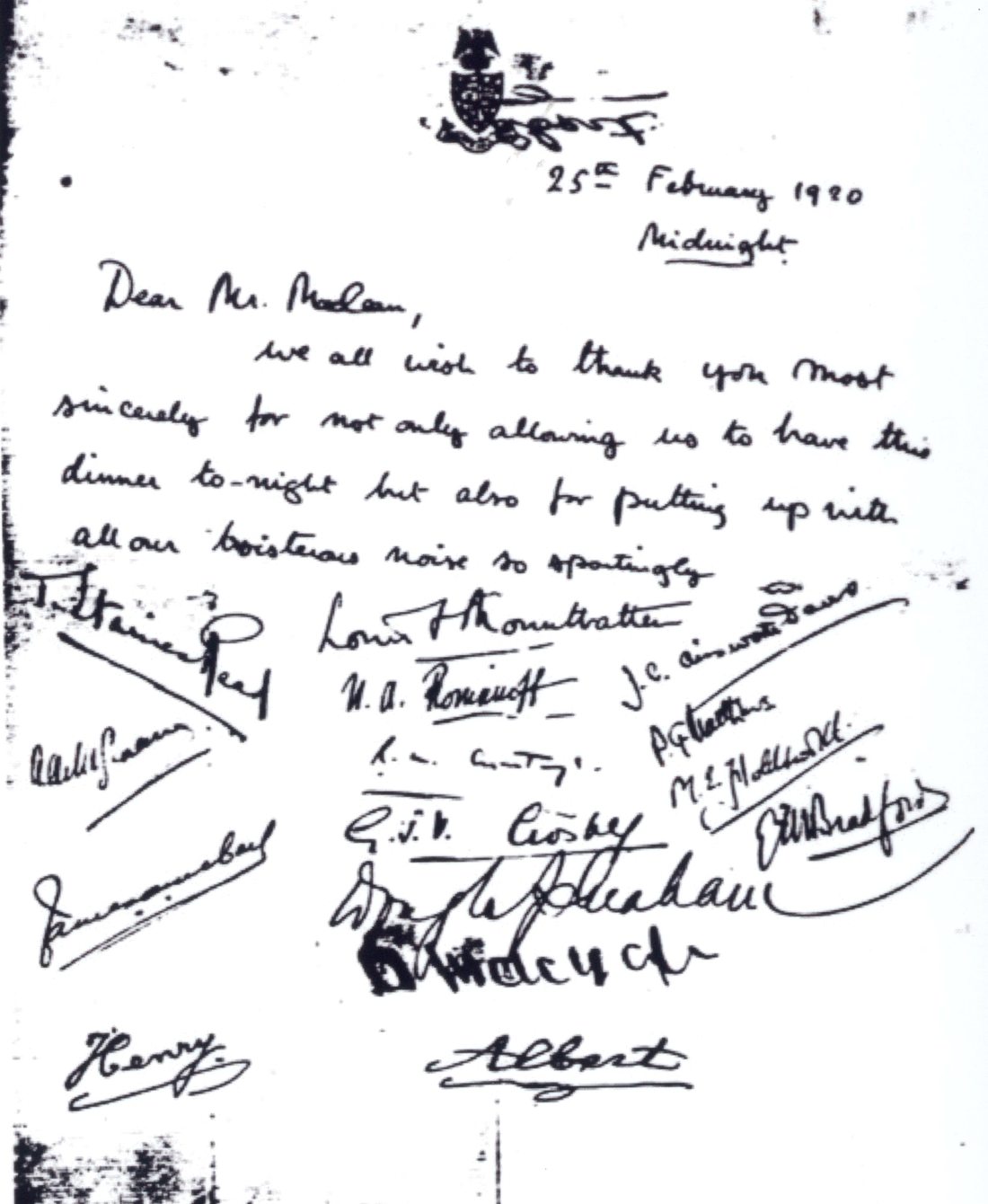Auction: 16003 - Orders, Decorations, Campaign Medals and Militaria
Lot: 7
SOLD BY ORDER OF A DIRECT DESCENDANT
An Outstanding Second War 1940 'Second Battle of Narvik' D.S.O. Group of Eight to Captain J.A. McCoy, Royal Navy, A Distinguished Destroyer Captain Who Had Served During the Great War, Who Went into Action at Narvik as the Senior Officer of the Destroyer Force, 1940, Earning Mentions for Operation Claymore, 4.3.1941 and Anti-Submarine Action During Convoy ONS5, Captain of H.M.S. Offa During Arctic Convoy JW55B, Which Lead to the Sinking of the Scharnhorst, 22-29.12.1943
a) Distinguished Service Order, G.VI.R., silver-gilt and enamel, reverse of suspension bar officially dated '1940', with integral top riband bar
b) British War and Victory Medals (S.Lt. J.A. McCoy R.N.)
c) 1939-1945 Star
d) Atlantic Star, with France and Germany Bar
e) Arctic Star, with the box of issue, named to 'Capt J A McCoy RN'
f) Defence and War Medals, M.I.D. Oak Leaf, light contact marks, very fine, together with the following related material:
- Bestowal Document for the D.S.O.
- Bestowal Document and Admiralty Enclosure for the Order of St. Olav
- The four M.I.D. certificates, in named envelope of delivery
- Eight photographs (five original, three copied) of the recipient, four including images of vessels in combat
- Copied service records (8)
D.S.O. London Gazette 28.6.1940 Commander James Abernethy McCoy, Royal Navy, H.M.S. Bedouin
'For daring, resource and devotion to duty in the second Battle of Narvik'
M.I.D. London Gazette 11.7.1940 Commander James Abernethy McCoy, Royal Navy
M.I.D. London Gazette 26.9.1940 Commander James Abernethy McCoy, D.S.O., Royal Navy, H.M.S. Bedouin
M.I.D. London Gazette 12.8.1941 Captain James Abernethy McCoy, D.S.O., Royal
Navy
M.I.D. London Gazette 10.9.1943 Captain James Abernethy McCoy, D.S.O., H.M.S. Offa, Royal Navy
[Norway, Order of St. Olav, Commander] London Gazette 13.1.1948 Captain James Abernethy McCoy, D.S.O., Royal Navy
Captain James Abernethy McCoy, D.S.O., was born 17.6.1900; served with the Royal Navy during the Great War; commissioned Midshipman, 15.7.1916; promoted Sub-Lieutenant, 15.1.1919; educated at Christ's College, Cambridge; Lieutenant, 15.10.1920; Lieutenant-Commander, 15.10.1928; Commander, 30.6.1935; served with the Royal Navy during the Second War; Captain, 30.6.1941; retired, 7.7.1950; died, 1955.
A Royal Education
Following service during the Great War as a Junior Naval Officer, McCoy was enrolled upon a quite extraordinary year at Cambridge. An article featured in Christ's College Magazine, Max Holdsworth, May 1980 elaborates following the assassination of Lord Mountbatten:
'In October 1919, by arrangement between the University and the Admiralty, a group of junior Royal Navy Officers came up to Cambridge for a special one year course, intended, it was understood, to make good omissions which had had to be made in their wartime training. They were accommodated a few at each College and so it was that Sub-Lieutenant Lord Louis Mountbatten, R.N., and two other young Officers, Bradford and McCoy came to Christ's. He had a small room at the top of C staircase and the other two shared B2. Right from the start he entered fully into College life; in particular I remember him in the Milton Society and the College 2nd Hockey XI and to everyone he expected to be plain "Mountbatten".
My own outstanding recollection of his stay at Christ's is the quite unforgettable farewell part which he gave when his time at Cambridge was cut short by his being posted to go as A.D.C. to his cousin the Prince of Wales on his Australian tour in the Renown, in 1920. He invited 12 members of the College and also his two cousins who were at the time in residence at Trinity, Prince Albert, later King George VI, and Prince Henry, later Duke of Gloucester. The party was held in Bradford and McCoy's room as his own room was too small. It was a proper undergraduate jollification enjoyed to the full by all of us including the two visitors from Trinity. So much so that it was thought proper to write a letter to the don whose room (B4) was directly above the party to thank him for his forbearance.'
This letter is illustrated in this catalogue and notably also features the signature of Nicolas Romanoff.
Such was McCoy's relationship with Mountbatten that he was asked to carry the medals of his father, Prince Louis of Battenberg, during his State Funeral in 1921.
H.M.S. Bedouin, Operation Claymore and the Second Battle of Narvik
McCoy was appointed in Command of H.M.S. Bedouin, a 'Tribal' Class Destroyer prior to the commencement of hostilities, 1.3.1939. With the order of the Nazi invasion of Norway ordered at the start of March 1940, the German Kriegsmarine at a force of 10 destroyers reached the Ofot Fjord on the morning of 9.3.1940, met a Norwegian force numbering only 2 coastal defence vessels and quickly swept them aside, sinking both at the loss of 343 lives. Narvik was conquered and it was the intention that the German vessels returned that same evening, however due to heavy fog and snow, in combination with a slowness of re-fuelling the vessels were required to stay at port. Upon the Norwegian invasion the Royal Navy had taken every opportunity to engage the Kriegsmarine at every possible juncture, this invitation was not declined either. A flotilla of 5 British destroyers sailed up the Fjord to engage the Kriegsmarine, 10.3.1940, both sides with the loss of two destroyers sunk before the Royal Navy regrouped and left the Fjord.
Following the First Battle of Narvik, the Admiralty reiterated the importance of the defeat of the Kriegsmarine at Narvik. As such Vice Admiral William Whitworth, K.C.B., D.S.O., in the battleship H.M.S. Warspite, together with 9 destroyers, including H.M.S. Bedouin under the command of McCoy and aircraft launched from the carrier H.M.S. Furious were dispatched with orders to engage and inflict defeat. The flotilla arrived into the Ofot Fjord, 13.3.1940 to discover the remaining 8 destroyers short of fuel and ammunition. With the engagements commencing, the Royal Navy fought a decisive victory, resulting in all 8 German vessels sunk or scuttled, together with the loss of U-64. H.M.S. Bedouin was attacked and one of three destroyers damaged during the Battle following engagements with the Wolfgang Zenker, Bernd von Arnim, Hans Ludemann and Hermann Künne. McCoy was awarded the D.S.O. and a Mention in Despatches for the Battle, earning a second Mention in September 1940.
Bedouin was once again engaged during Operation Claymore, 4.3.1941, during which five vessels of the 6th Destroyer Flotilla successfully landed Commandos to complete a raid upon the vital fish oil and glycerine centres upon the Loften Islands, Norway. Following the raid, over 18,000 tonnes of shipping, 10 vessels and 228 men were captured, the most important captive however was a set of rotor wheels for the Enigma, taken from the armed trawler Krebs, earning McCoy his third Mention in Despatches. The service papers record 'Mentioned in Despatches for zeal and devotion to duty and the skilful handling of his ship whereby the success of the Operation was achieved.'
McCoy was promoted Captain in June 1941 and posted to the Liverpool Escort Force, 24.7.1941-5.9.1942. The service papers give more detail into this period:
'A very keen and able Captain with a very fine war record who during this one year's tenure of this appointment has raised the general standard of training and efficiency of the Liverpool Escort Force to a very high level. He deservedly has the complete confidence of his seniors and juniors alike. He has been untiring also in his successful efforts to improve the welfare of the Officers and men in his command. His invention of the Depth Charge Driller is an invaluable contribution to the efficient training of the crews of Escort Vessels in A/S (Anti-Submarine) work and is deserving of the highest credit. An excellent mixer, he has endeared himself to the local civil authorities of all types, who, I know, regret his departure from the command as keenly as I do myself. Admiral Noble, 1.9.1942.'
Convoy ONS 5 and a Fourth 'Mention'
McCoy took command of H.M.S. Offa, an 'O' Class Destroyer, 12.3.1943-3.6.1943, earning his fourth Mention in Despatches '...for great skill and daring in action with enemy submarines in the Atlantic.'
Offa entered the Convoy, 29.4.1943, which had left Liverpool, 21.4.1943, when Captain McCoy was ordered to offer reinforcements as Commander of the 3rd Support Group, comprising 4 destroyers who sailed from Newfoundland to assist and provide support to the Convoy which was encountering deteriorating weather in combination with the threat of U-Boat interception. By 30.4.1943, the Convoy faced Force 10 gales and was only making 3 knots, resulting in the order to scatter due to the risk of the destroyers running at a critical state of fuel. This eventually happened, with Offa requiring to be refuelled by an oil tanker during the afternoon of 5.5.1943.
That very evening, from 2150hrs the Selvistan, Gharinda, and Bonde were struck by a salvo of torpedoes from U-266, all three sunk at the loss of 110. H.M.S. Tay recovered 52 survivors whilst Offa replied by laying depth charges, successfully damaging U-266, which was successfully sunk, 14.5.1943, off the north-west coast of Spain whilst attempting to return for repair by a Halifax Bomber of No. 58 Squadron.
The Convoy reached port, 6.5.1943, following a week in which it had suffered attacks from over 40 U-Boats. 13 Allied Merchant vessels were lost, whilst the German losses totalled 6 U-Boats sunk and a further 7 damaged, including U-266.
Arctic Convoy JW 55B
McCoy's final command was of H.M.S. Onslow, another 'O' Type, 3.6.1943-9.9.1944 which had the honour of taking King George VI aboard, 12.8.1943, in transferring him to Scapa Flow for a visit to the Home Fleet. Illustrated, alongside H.M. is McCoy wearing his infamous 'ski cap'. It would appear that he did not favour a Naval cap and this improvised example is pictured on numerous occasions, including during the entry to the Second Battle of Narvik.
On 22.12.1943, 19 merchant vessels left Loch Ewe, destined for Murmansk, Russia. Close Escort was provided by two destroyers, whilst the Ocean Escort under the command of McCoy comprised eight destroyers. The convoy was sighted, 22.12.1943 and soon German aircraft shadowed the route of the vessels, being sighted and fired upon by U-716, 25.12.1943, but most importantly Admiral Bey aboard the Scharnhorst was authorised and ordered to sortie with the convoy. As such JB55B was used as a bait to result in an engagement with the Royal Navy Fleet, who ordered the convoy to slow to 8 knots in order to initiate the contact. On this occasion the British planning was a success, the Scharnhorst being met, engaged and sunk by H.M.S. Duke of York, at the Battle of the North Cape, 26.12.1943. Convoy JB55B proceeded to reach Kola Bay, with the safe arrival of all 19 Merchant Vessels, 30.12.1943.
The Order of St. Olav, Commander's neck Badge was returned to the Norwegian Chancery by the family following the passing of the recipient, as the Statutes of the Order.
Subject to 20% VAT on Buyer’s Premium. For more information please view Terms and Conditions for Buyers.
Sold for
£4,200

